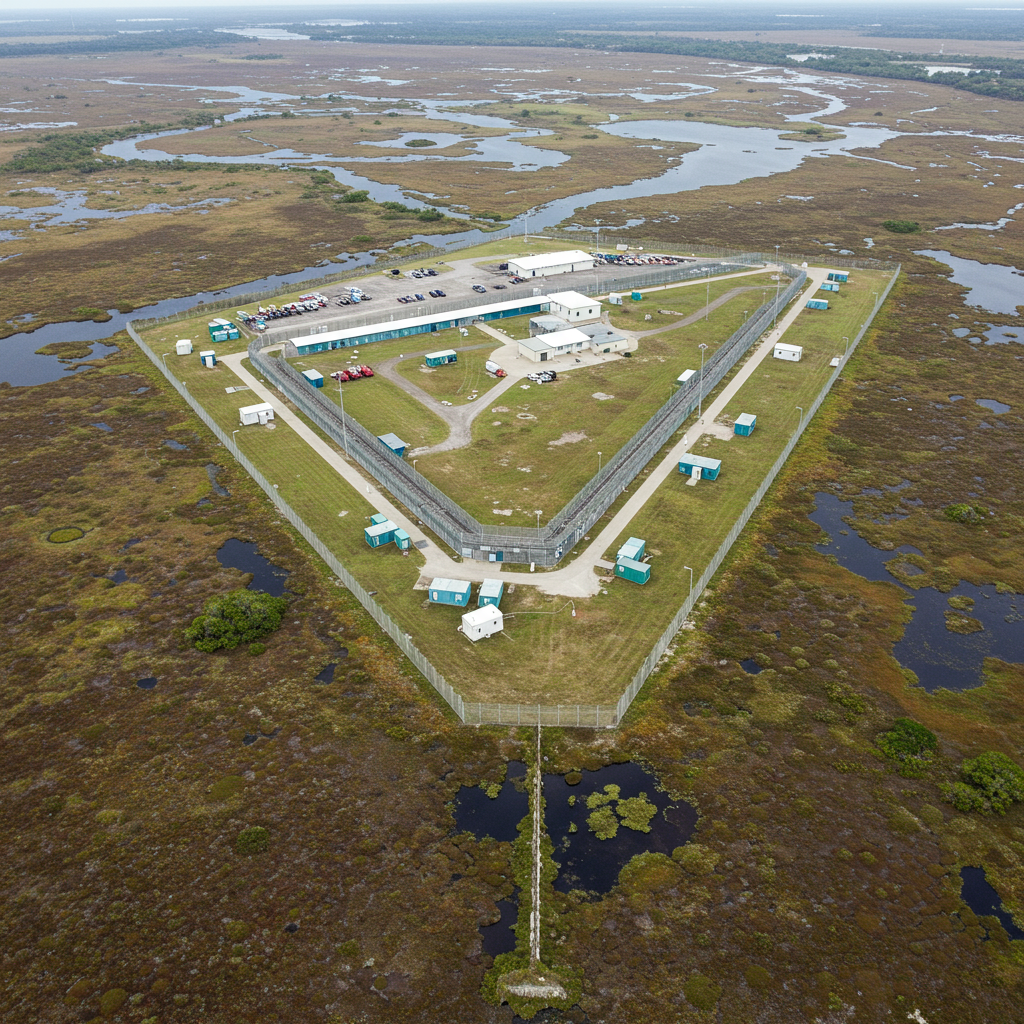Florida’s Controversial “Alligator Alcatraz” Migrant Facility
Deep within the vast, ecologically sensitive subtropical wetland of the Florida Everglades – a designated UNESCO World Heritage Site – a controversial project is rapidly taking shape. What was once the Dade-Collier Training and Transition Airport, a largely abandoned airfield primarily used for pilot training, is being transformed into a large-scale migrant detention facility. Colloquially and controversially dubbed “Alligator Alcatraz,” this new center is sparking intense debate and raising significant environmental and humanitarian concerns.
Construction crews, bringing in supplies like tents, building materials, and portable toilets, are laying the groundwork for a complex designed to house up to 1,000 detainees. Located approximately 43 miles (70km) west of central Miami, the site is surrounded by dense swamps known for their dangerous wildlife, including alligators and pythons.
Driven by Deportation Goals
The impetus for this unusual location stems from a push to accelerate migrant deportations, aligning with former President Donald Trump’s stated agenda. Florida Governor Ron DeSantis initiated the project through a 2023 executive order, invoking emergency powers aimed at stemming the flow of undocumented migrants into the state.
State Attorney General James Uthmeier, a Republican, has highlighted the site’s remote and perilous surroundings as a key feature. In a video shared on social media, he suggested the location provides a “natural deterrent” against escapes. “You don’t need to invest that much in the perimeter,” Uthmeier stated, noting that if people were to escape, there’s “not much waiting for them other than alligators and pythons.” He added that the facility ensures there will be “nowhere to go, nowhere to hide.”
Homeland Security Secretary Kristi Noem also framed the project as a direct response to the call for mass deportations, specifically targeting “criminal illegal aliens.” She described the initiative as a “cost-effective and innovative” method to quickly expand detention capacity, suggesting facilities and bed space could be added “in just days” through the partnership with Florida.
Funding and Costs Raise Questions
Authorities state the facility is intended to be temporary, with operations expected to begin as early as July or August. Funding for the project is anticipated to come “in large part” from the Federal Emergency Emergency Management Agency’s (FEMA) shelter and services program. While FEMA is typically associated with disaster response, this funding mechanism is being used to support the facility.
However, the financial implications are substantial. While proponents like Uthmeier tout it as an “efficient” and “low-cost opportunity” for a temporary center, initial estimates suggest the annual running cost could reach approximately $450 million (£332 million).
Environmental and Humanitarian Fears Mount
Despite the government’s framing, the “Alligator Alcatraz” concept faces significant opposition and raises red flags among various groups.
Local residents and environmental organizations voice grave concerns about the potential impact on the fragile Everglades ecosystem. Betty Osceola, a member of the nearby Miccosukee Native American community, expressed “serious concerns about the environmental damage” to the protected wetlands. Miami-Dade County Mayor Daniella Levine Cava, whose county owns the airstrip land, has also publicly stated her office’s “clearly laid out several concerns” to the state, particularly regarding the environmental consequences of the project. While Attorney General Uthmeier maintains the facility is not located directly within Everglades National Park boundaries, environmental groups like Friends of the Everglades remain apprehensive about development in the broader ecosystem.
Human rights organizations are equally alarmed, focusing on the potential conditions for detainees in such an isolated and harsh environment. The American Civil Liberties Union (ACLU) of Florida called the proposed facility “cruel and absurd,” arguing it reflects how the immigration system is being increasingly used “to punish people rather than process them.” The ACLU points to a history of “medical neglect, denial of legal access, and systemic mistreatment” even in ICE detention centers located in more populated areas, raising fears that conditions could be worse in such a remote location.
There are also doubts about the facility’s stated temporary nature. Betty Osceola suggested the site could operate for months or even years, not just briefly.
A Symbol of Broader Policy
The development in the Everglades comes at a time when Immigration and Customs Enforcement (ICE) centers nationwide are reportedly significantly overcrowded. Data cited by CBS News indicated ICE holding a record 59,000 detainees, 140% above its official capacity.
As the push for accelerated mass deportations continues, expanding detention capacity has become a key challenge for the administration. Governor DeSantis has even hinted that the Everglades site might not be the last such facility, mentioning the possibility of a similar center being established at Camp Blanding, a former military site over 300 miles north.
While immigration operations may currently appear less widespread in Miami-Dade County compared to other areas, the fear of arrest and detention is palpable. Testimonies indicate many undocumented individuals are staying home to avoid potential capture and transport to facilities like the one being built in the desolate expanse of the Everglades – a place proponents describe as offering escapees “nowhere to go, nowhere to hide.”



